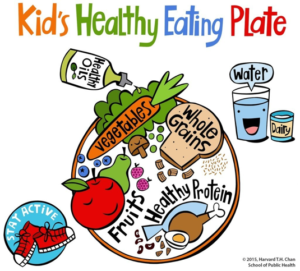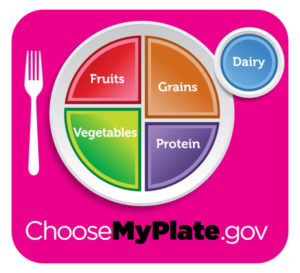
Harvard’s T.H. Chan School of Medicine’s Kids Healthy Eating Plate
As W.E.B. DuBois said, “Children learn more from what you are than what you teach.” Want to get the children in your life to eat more nutritiously? Start by doing it yourself.
This blog emphasizes the importance of changing one or two habits at a time in order to make lasting change. If you want to teach your children to eat nutritiously, you are teaching (and learning) skills for a lifetime. Here are a few things to try and see what works for your family.
To Eat Nutritiously, Arm Yourself with Information

US Department of Agriculture’s MyPlate icon
In the hopes of enticing and empowering children, nutritionists at the T.H. Chan school of Medicine took the US Department of Agriculture’s MyPlate icon and pumped it up to create the Kid’s Healthy Eating Plate. This image focuses on quality of diet, and is designed to help teach healthy eating and physical activity behaviors to children. A quick comparison of the two images shows that the T.H. Chan icon will be more interesting to children, and is even easier for adults to use to make healthier eating choices. Learn the basic principles taught in the second icon and refer to that information as you teach your children.
The Kid’s Healthy Eating Plate image shows a colorful balance of food, and emphasizes a variety of food choices illustrating the importance of getting nutrition from many sources. This variety is key to a diet that has healthy mix of “macronutrients” (carbohydrates, proteins and fats) and “micronutrients” (vitamins and minerals).
Main Points to Remember from the Icon
According to TH Chan, “The more veggies – and the greater the variety – the better.” And remember, “Potatoes and French fries don’t count as vegetables because of their negative impact on blood sugar.”
To teach children to eat nutritiously, practice some easy tricks like selecting fruits of many colors, and remembering that fruit juice doesn’t count as fruit. Fruit juice has all the sugar of fruit, with none of the fiber. Eating whole fruit is always better than drinking the juice.
As far as grains go, choose the least processed grains possible. This means your body uses more energy in converting the grains to sugar—it reduces the sugar rush from products made with white flour. Grains and healthy proteins each make up one quarter of the plate, so their serving size should be smaller than vegetable and fruits.
When you teach children about proteins, mention nuts, seeds, beans and peas, eggs, fish and poultry. Thinking of this category as proteins, not just meat helps to include some healthier options. Red meats are a great item to limit. Encourage children to order red meats while out at restaurants or on special occasions. Processed meats like hot dogs, lunch meats, bacon and sausages should generally be avoided. On the occasions where you do shop for those foods, look for nitrite-free/organic options.
Now, to apply the knowledge you learned from the Kid’s Healthy Eating Icon:
Grow Your Own
Whether you are growing plants in pots on a balcony or in a garden plot, let your child (no matter how old) pick some seeds to plant, and put them in the ground, help weed, and harvest the crops.
Find Weird Fruits or Vegetables
Most children are curious about odd things. Once a week bring home strange-looking or unusual produce like star fruit, dragon fruit, coconuts, sugar cane, jicama, parsnips. A little research before your purchase will help you learn how to cut, prepare and serve these new taste delights. Read recipe reviews and look for the best ratings—the internet is a great source for finding child-friendly recipes.
Expand Your Reading Horizons
Check your local library for a plethora of books about vegetables. Check out The Giant Carrot by Jan Peck and Sylvia’s Spinach by Katherine Pryor for inspiration to eat nutritiously. To discover more great books that peak children’s interest, click here.
Do it Yourself
Make healthy food for your family—older and younger children can help with this. Instead of sodas or juices, make fruit-infused water by adding your favorite produce to a pitcher of water. Lemons, limes, cucumbers, berries, mint are some great additions. Sparkling juices are refreshing—simply add an ounce or two of fresh juice to 12oz of sparkling water.
These choices above, plus the seemingly-infinite suggestions on the internet will provide even more ideas. Remember to pick one or two things to implement. It’s easy in our world to become overwhelmed by all the information that is at our fingertips. The most important thing is to talk to your children, find out what they are interested in trying and then give it a whirl. Making eating, cooking and healthy food choices fun is also an enormous help in getting children interested.





